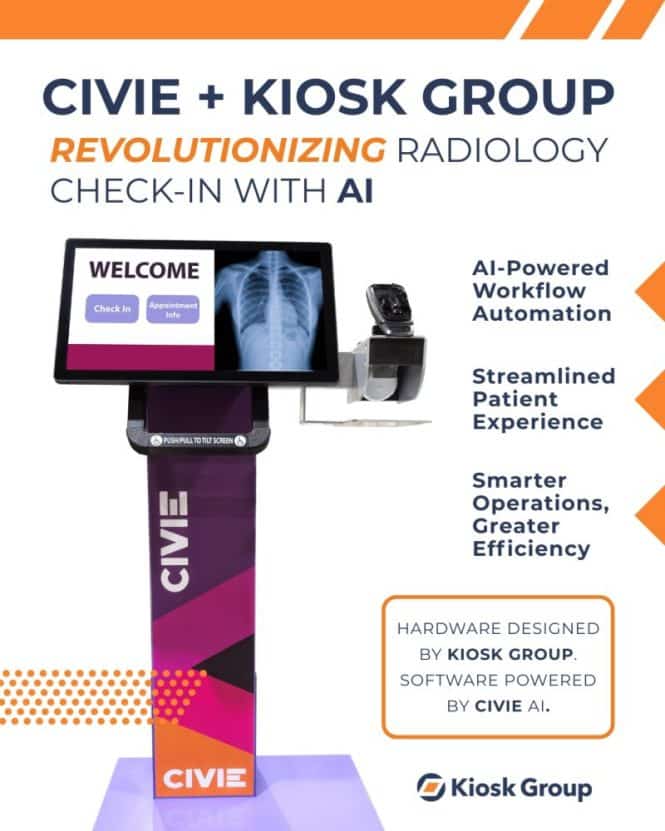
Healthcare Kiosk Check-in with AI for Radiology
April 7, 2025 — REVOLUTIONIZING RADIOLOGY CHECK-IN WITH AI 🤖
Kiosk Group and CIVIE have joined forces to transform radiology departments nationwide. 🏥 Our custom kiosk solution uses AI to automate check-ins, streamline patient workflows, and sync seamlessly with RIS/PACS systems — delivering faster, smarter, and more efficient care from the very first tap. ✨🩻💡
Contact Aaron at [email protected]
👉 🛠️ Hardware Designed by Kiosk Group. ⚙️ Software Powered by CIVIE AI.
Obvious Question — What is RIS PACS?
RIS (Radiology Information System) and PACS (Picture Archiving and Communication System) are essential technologies in modern radiology departments, designed to manage different aspects of patient care and imaging workflows.
RIS: Radiology Information System
A RIS is a specialized software system focused on the administrative and workflow management aspects of radiology. Its core functionalities include:
-
Patient Management: Tracking patient data from registration to discharge, including scheduling appointments and monitoring treatment progress14.
-
Workflow Optimization: Facilitating radiology workflows by managing orders, tracking imaging procedures, and generating reports36.
-
Billing: Automating billing processes, storing financial records, and processing insurance claims4.
-
Integration: Often integrated with Hospital Information Systems (HIS) and Electronic Health Records (EHR) to unify patient data across departments25.
RIS is primarily used by administrative staff, radiologists, and technologists to streamline operations and ensure accurate recordkeeping.
PACS: Picture Archiving and Communication System
PACS is a medical imaging technology designed for the storage, retrieval, distribution, and display of medical images. Key features include:
-
Image Management: Handling digital images from modalities like X-rays, CT scans, MRIs, etc., using the DICOM standard for interoperability13.
-
Accessibility: Allowing radiologists and clinicians to securely access images for diagnosis, consultation, or treatment planning5.
-
Efficiency: Eliminating the need for physical film storage by providing digital solutions for archiving and sharing images15.
-
Integration: PACS integrates with RIS, HIS, and EHR systems to provide seamless access to both imaging data and patient records24.
PACS is primarily used by radiologists for analyzing medical images and collaborating with other healthcare professionals.
Integration of RIS and PACS
When integrated, RIS and PACS create a unified system that enhances efficiency in radiology departments. Benefits include:
-
Streamlined Workflows: Reducing redundancy by linking administrative data with imaging records14.
-
Improved Patient Care: Providing a comprehensive view of patient history, ensuring faster diagnoses and treatment decisions4.
-
Cost Savings: Minimizing errors and manual processes through automation14.
Together, RIS focuses on managing patient information while PACS handles medical imaging data. Their collaboration ensures optimal radiology operations and better healthcare outcomes.
More Healthcare Kiosk
- Healthcare Check In Kiosk
- Patient Kiosk in Healthcare – Top 5 Reasons to Use – Kiosk Industry
- Category Archives: EPIC Patient Check-in Kiosks
- Four Important Rules for Healthcare Stations and Kiosks
- The Role of Health Kiosks: Scoping Review – JMIR Medical Informatics
Trivia
-
Purpose:MUMPS was designed to build database applications, making it well-suited for the needs of the healthcare industry, which relies heavily on patient databases like EHRs.
-
- Database Integration: MUMPS has a built-in, integrated database, allowing direct access to disk storage using simple symbolic program variables and subscripted arrays.
- ACID Transaction Processing: It provides Atomic, Consistent, Isolated, and Durable (ACID) transaction processing, ensuring data integrity.
- Minimalist EHR Language: MUMPS is considered a minimalist EHR language, designed to be memory-usage efficient, which was crucial in the late 1960s when computer memory was limited.
- Database Integration: MUMPS has a built-in, integrated database, allowing direct access to disk storage using simple symbolic program variables and subscripted arrays.
-
Developed in the late 1960s at Massachusetts General Hospital, MUMPS was used as the programming language for the first EHRs.
-
While other programming languages and database systems have emerged, MUMPS remains in use by some EHR vendors and in systems like the Veterans Health Information Systems and Technology Architecture (VistA), which manages the electronic health records for 8 million veterans.
